1. Prinz P. The role of dietary sugars in health: molecular composition or just calories? Eur J Clin Nutr. 2019; 73:1216–1223. PMID:
30787473.

2. Debras C, Chazelas E, Srour B, Kesse-Guyot E, Julia C, Zelek L, Agaësse C, Druesne-Pecollo N, Galan P, Hercberg S, et al. Total and added sugar intakes, sugar types, and cancer risk: results from the prospective NutriNet-Santé cohort. Am J Clin Nutr. 2020; 112:1267–1279. PMID:
32936868.

3. World Health Organization. Guideline: Sugars Intake for Adults and Children. Geneva: World Health Organization;2015.
4. Singh GM, Micha R, Khatibzadeh S, Lim S, Ezzati M, Mozaffarian D. Global Burden of Diseases Nutrition and Chronic Diseases Expert Group (NutriCoDE). Estimated global, regional, and national disease burdens related to sugar-sweetened beverage consumption in 2010. Circulation. 2015; 132:639–666. PMID:
26124185.

5. Bray GA, Popkin BM. Dietary sugar and body weight: have we reached a crisis in the epidemic of obesity and diabetes?: health be damned! Pour on the sugar. Diabetes Care. 2014; 37:950–956. PMID:
24652725.

6. Sigman-Grant M, Morita J. Defining and interpreting intakes of sugars. Am J Clin Nutr. 2003; 78:815S–826S. PMID:
14522745.

7. US Government Printing Office. Dietary Guidelines for Americans, 2020. 8th ed. Washington, D.C.: US Government Printing Office;2020.
8. Korean Nutrition Society, Ministry of Health and Welfare. Dietary Reference Intakes for Koreans 2020. Sejong: Ministry of Health and Welfare;2020.
9. Wittekind A, Walton J. Worldwide trends in dietary sugars intake. Nutr Res Rev. 2014; 27:330–345. PMID:
25623085.

10. Lee HS, Kwon So, Yon M, Kim D, Lee JY, Nam J, Park SJ, Yeon JY, Lee SK, Lee HY, Kwon OS, Kim CI. Dietary total sugar intake of Koreans: based on the Korea National Health and Nutrition Examination Survey (KNHANES), 2008–2011. J Nutr Health. 2014; 47:268–276.

11. Rauber F, Louzada MLDC, Martinez Steele E, Rezende LFM, Millett C, Monteiro CA, Levy RB. Ultra-processed foods and excessive free sugar intake in the UK: a nationally representative cross-sectional study. BMJ Open. 2019; 9:e027546.

12. Martínez Steele E, Baraldi LG, Louzada ML, Moubarac JC, Mozaffarian D, Monteiro CA. Ultra-processed foods and added sugars in the US diet: evidence from a nationally representative cross-sectional study. BMJ Open. 2016; 6:e009892.

13. Cediel G, Reyes M, da Costa Louzada ML, Martinez Steele E, Monteiro CA, Corvalán C, Uauy R. Ultra-processed foods and added sugars in the Chilean diet (2010). Public Health Nutr. 2018; 21:125–133. PMID:
28625223.

14. Machado PP, Steele EM, Louzada MLDC, Levy RB, Rangan A, Woods J, Gill T, Scrinis G, Monteiro CA. Ultra-processed food consumption drives excessive free sugar intake among all age groups in Australia. Eur J Nutr. 2020; 59:2783–2792. PMID:
31676952.

15. Latasa P, Louzada MLDC, Martinez Steele E, Monteiro CA. Added sugars and ultra-processed foods in Spanish households (1990–2010). Eur J Clin Nutr. 2018; 72:1404–1412. PMID:
29277837.

16. Monteiro CA, Cannon G, Levy RB, Moubarac JC, Louzada ML, Rauber F, Khandpur N, Cediel G, Neri D, Martinez-Steele E, et al. Ultra-processed foods: what they are and how to identify them. Public Health Nutr. 2019; 22:936–941. PMID:
30744710.

17. Shim JS, Shim SY, Cha HJ, Kim J, Kim HC. Association between ultra-processed food consumption and dietary intake and diet quality in Korean adults. J Acad Nutr Diet. Forthcoming. 2021.

18. Blanton CA, Moshfegh AJ, Baer DJ, Kretsch MJ. The USDA automated multiple-pass method accurately estimates group total energy and nutrient intake. J Nutr. 2006; 136:2594–2599. PMID:
16988132.

19. Kweon S, Kim Y, Jang MJ, Kim Y, Kim K, Choi S, Chun C, Khang YH, Oh K. Data resource profile: the Korea National Health and Nutrition Examination Survey (KNHANES). Int J Epidemiol. 2014; 43:69–77. PMID:
24585853.

20. Ministry of Health and Welfare, Korea Centers for Disease Control and Prevention. Guidelines for Nutrition Survey: Korea National Health and Nutrition Examination Survey 6th (2013–2015). Cheongju: Korea Centers for Disease Control and Prevention;2015.
21. Korea Centers for Disease Control and Prevention. 2016–2018 Guidebook for Using the Data from Korea National Health and Nutrition Examination Survey. Cheongju: Korea Centers for Disease Control and Prevention;2020.
22. Yeon SY, Kweon SH, Oh KW. The daily dietary sugar intake in Korea, 2018. Public Health Wkly Rep. 2020; 13:359–363.
23. Monteiro CA, Cannon G, Moubarac JC, Levy RB, Louzada ML, Jaime PC. The UN Decade of Nutrition, the NOVA food classification and the trouble with ultra-processing. Public Health Nutr. 2018; 21:5–17. PMID:
28322183.

24. Ricciuto L, Fulgoni VL, Gaine PC, Scott MO, DiFrancesco L. Sources of added sugars intake among the U.S. population: analysis by selected sociodemographic factors using the National Health and Nutrition Examination Survey 2011–18. Front Nutr. 2021; 8:687643. PMID:
34222307.

25. Fisberg M, Kovalskys I, Gómez G, Rigotti A, Sanabria LYC, García MCY, Torres RGP, Herrera-Cuenca M, Zimberg IZ, Koletzko B, et al. Total and added sugar intake: assessment in eight Latin American Countries. Nutrients. 2018; 10:389.

26. Shim JS, Kang NH, Lee JS, Kim KN, Chung HK, Chung HR, Kim HJ, Ahn YS, Chang MJ. Socioeconomic burden of sugar-sweetened beverages consumption in Korea. Nutr Res Pract. 2019; 13:134–140. PMID:
30984357.

27. Xi B, Huang Y, Reilly KH, Li S, Zheng R, Barrio-Lopez MT, Martinez-Gonzalez MA, Zhou D. Sugar-sweetened beverages and risk of hypertension and CVD: a dose-response meta-analysis. Br J Nutr. 2015; 113:709–717. PMID:
25735740.

28. Wiener RC, Shen C, Findley PA, Sambamoorthi U, Tan X. The association between diabetes mellitus, sugar-sweetened beverages, and tooth loss in adults: evidence from 18 states. J Am Dent Assoc. 2017; 148:500–509.e4. PMID:
28483048.
29. Bernabé E, Vehkalahti MM, Sheiham A, Aromaa A, Suominen AL. Sugar-sweetened beverages and dental caries in adults: a 4-year prospective study. J Dent. 2014; 42:952–958. PMID:
24813370.

30. Anari R, Amani R, Veissi M. Sugar-sweetened beverages consumption is associated with abdominal obesity risk in diabetic patients. Diabetes Metab Syndr. 2017; 11(Suppl 2):S675–S678. PMID:
28487104.

31. Malik VS, Hu FB. Fructose and cardiometabolic health: what the evidence from sugar-sweetened beverages tells us. J Am Coll Cardiol. 2015; 66:1615–1624. PMID:
26429086.
32. Vandevijvere S, Jaacks LM, Monteiro CA, Moubarac JC, Girling-Butcher M, Lee AC, Pan A, Bentham J, Swinburn B. Global trends in ultraprocessed food and drink product sales and their association with adult body mass index trajectories. Obes Rev. 2019; 20(Suppl 2):10–19. PMID:
31099480.

33. Moubarac JC, Batal M, Martins AP, Claro R, Levy RB, Cannon G, Monteiro C. Processed and ultra-processed food products: consumption trends in Canada from 1938 to 2011. Can J Diet Pract Res. 2014; 75:15–21. PMID:
24606955.

34. Shim JS, Oh K, Kim HC. Dietary assessment methods in epidemiologic studies. Epidemiol Health. 2014; 36:e2014009. PMID:
25078382.

35. Willett WC. Nutritional Epidemiology. Oxford: Oxford University Press;2012.
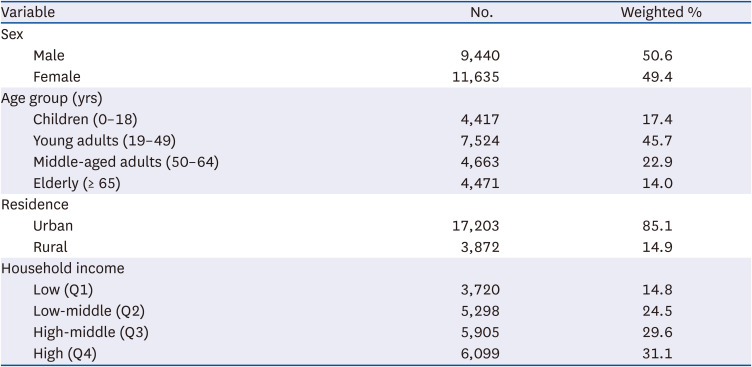
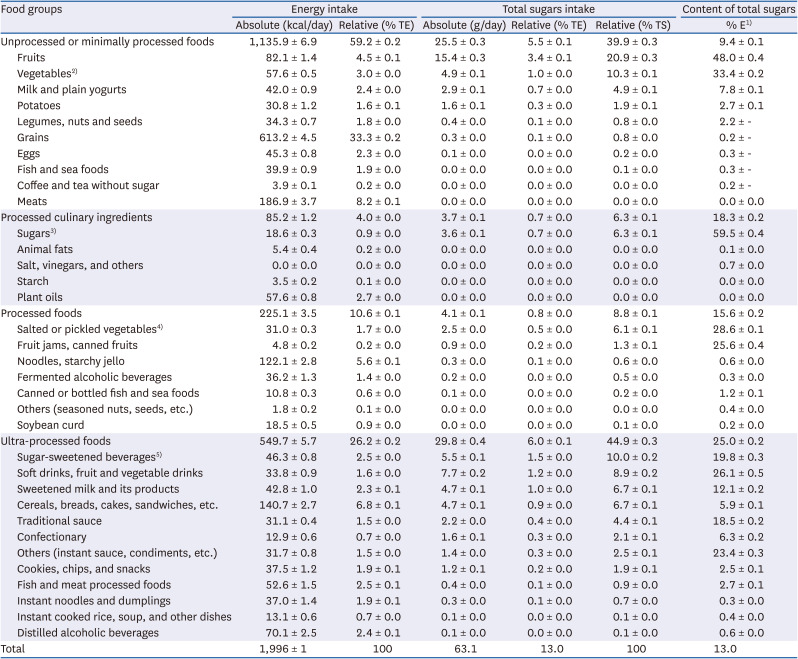
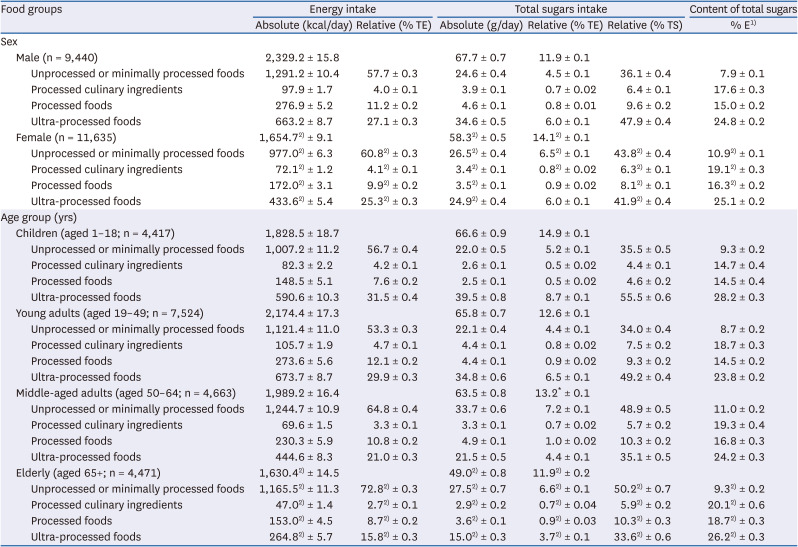
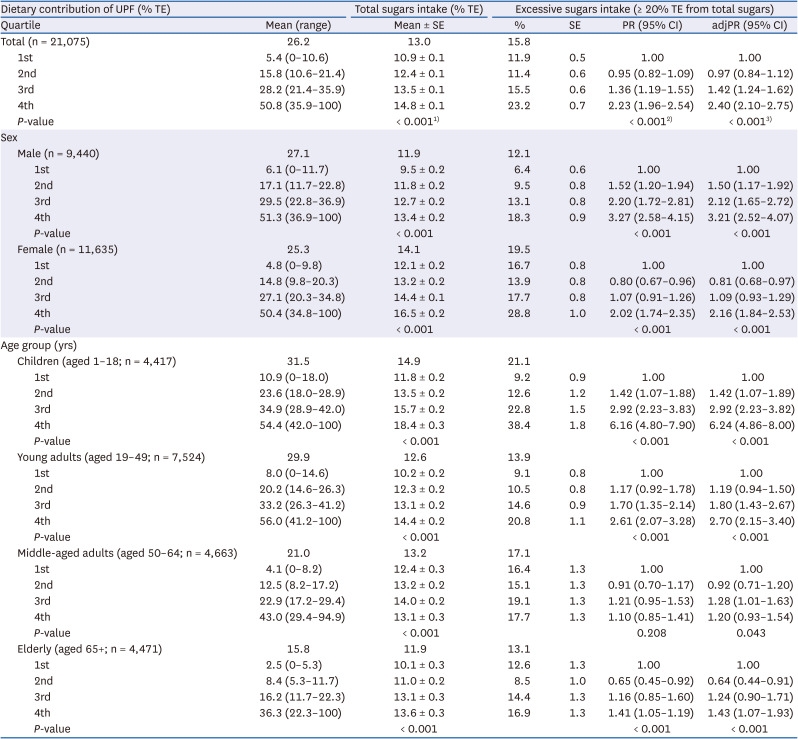
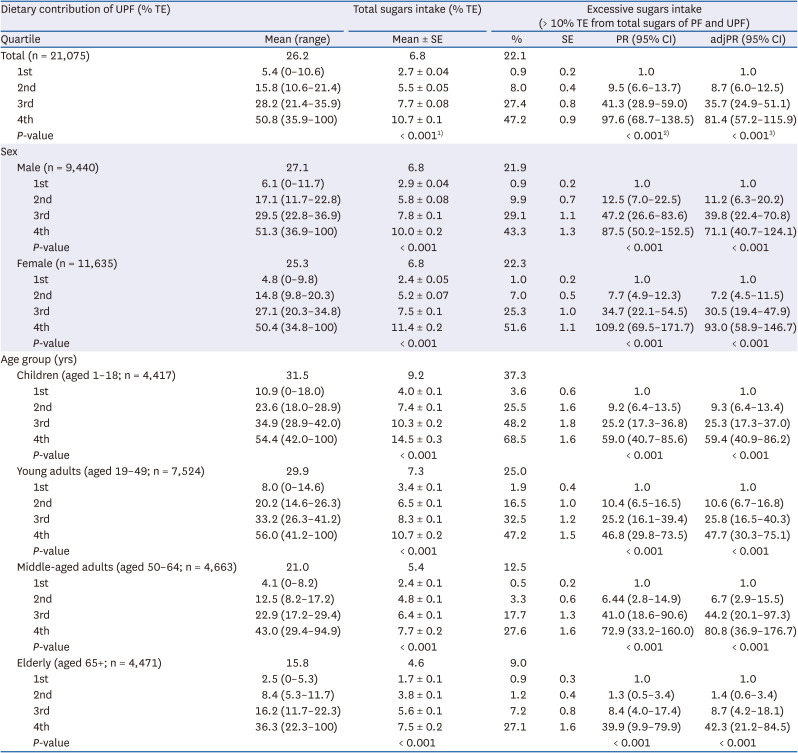




 PDF
PDF Citation
Citation Print
Print



 XML Download
XML Download